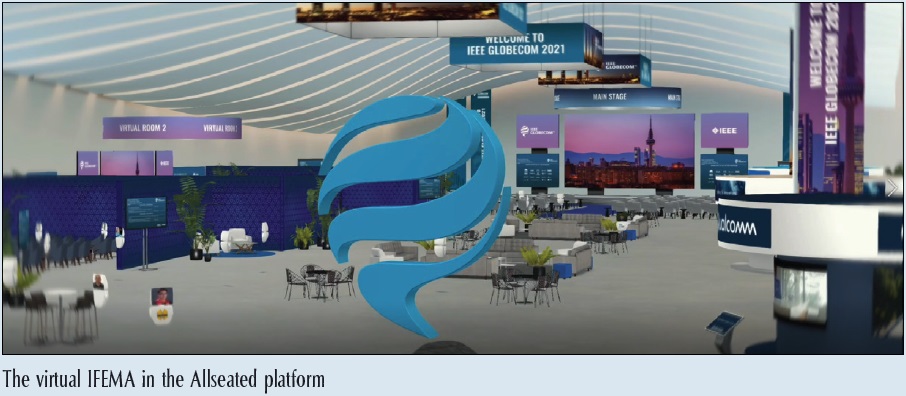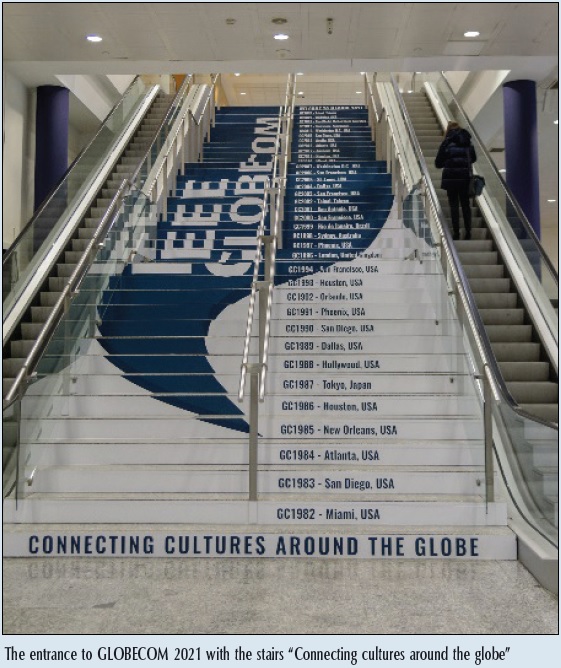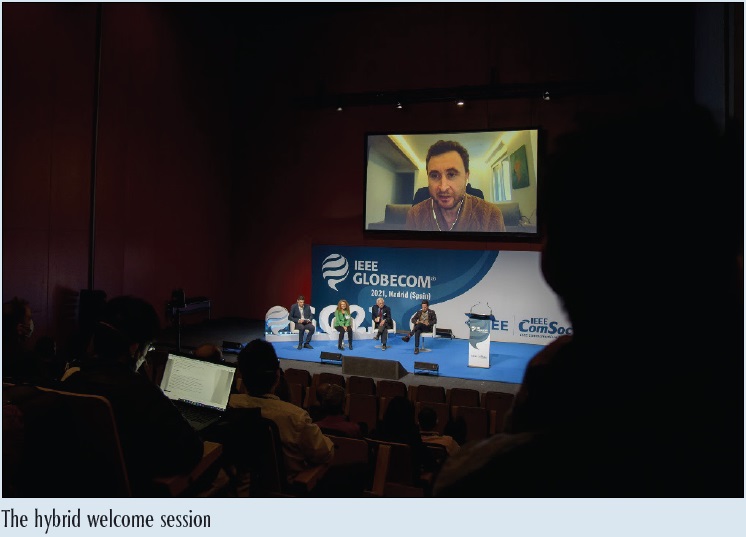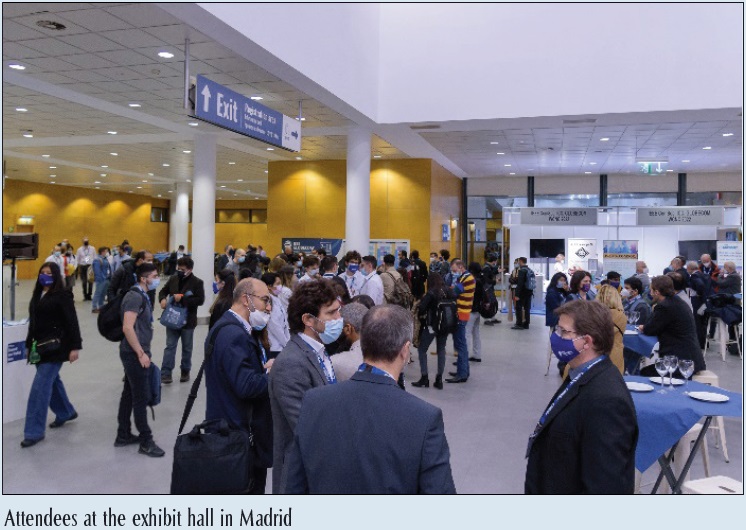

The 2021 IEEE Global Communications Conference (GLOBECOM) was held in Madrid, Spain, on 7–11 December 2021. Themed “Connecting Cultures around the Globe,” this flagship conference of the IEEE Communications Society (ComSoc) was the first physical meeting for many of us since the beginning of the pandemic. The attendees enjoyed the modern facilities of the North Convention Center of IFEMA, the Trade Fair Institution of Madrid. However, not everybody could make it to Madrid due to international travel restrictions, so the conference was held in hybrid format with 516 registered in-person attendees and 1556 remote ones. The conference received the support of 18 patrons, exhibitors, and sponsors. Eleven of them participated in the Exhibition in Madrid, which was inaugurated at the Welcome Reception, where most of the attendees met their colleagues after two years.
The Hybrid Format
Due to the pandemic, this ComSoc flagship conference combined several ways of participation, which imposed a highly demanding challenge to the Organizing Committee (OC) who had to adapt to many changes even during the week of the conference. All the conference attendees had the opportunity to access the conference via three different channels:
-
The live onsite program: In-person attendees enjoyed a fully in-person technical and industry program, with technical symposia, workshops, and tutorials, as well as industry fora, panels, and presentations. After two years of virtual meetings, GLOBECOM 2021 included hybrid committee meetings for the first time. It also organized an attractive Young Professionals and WICE program, the i-Yes Education track, and a new Membership Value Research Congress organized in parallel. There was also a wonderful social program.
-
The live virtual program: GLOBECOM 2021 tested a metaverse-like platform called Allseated, where remote and onsite speakers could present in the same session and interact with the avatars of other remote and onsite speakers and attendees. The platform included three virtual rooms and an exhibition area similar to the physical one but with all 17 patrons and exhibitors, surrounded by the virtual skyline of Madrid.
-
The on-demand virtual program: All the presentations were made available on demand for all the conference attendees in the Conference Catalysts CONFlux virtual platform until the end of December, which imposed extra effort on the OC and the authors to get the pre-recorded presentations ready in time.

Live streaming from the main auditorium was a very good example of how communications technologies facilitate our life and work. The high-quality audio-visual production required a dedicated 100 Mb/s connection to be able to broadcast live to more than 1000 remote users at 1080p video quality. To avoid any latency in the communication, the remote speakers were connected to the same platform used for recording and producing the video from the main stage (vMix), and the composite stream was then broadcasted to the Allseated virtual platform. It allowed virtual avatars to feel as if they were at the auditorium, and in-person attendees to interact with people speaking from home. It also implied funny anecdotes such as a remote panellist’s son who appeared on the screen and didn’t want to leave the room.
But the main auditorium was not the only room with high-quality streamed sessions. After two years of absence, GLOBECOM 2021 celebrated again the Awards Luncheon, which was a hybrid ceremony where IEEE ComSoc Awards Committee Chair Alberto Leon-Garcia presented the awards remotely. Also, due to the imposed COVID-19 restrictions, the whole setup of this room was changed twice, once between the coffee break (75 high tables and 225 stools) and the awards luncheon (24 rounds of 10 people, a stage, and a special decoration), and a second time after the awards luncheon to recover the initial setup with high tables.
Conference Program

The attendees were greeted in the welcome session by the conference chairs, Ana Garcia Armada and Juan Manuel Corchado, and by the President of IEEE ComSoc, Vincent Chan. The session took place in the late afternoon, a quite unusual time that was chosen to facilitate the remote attendees from many parts of the globe. Sennur Ulukus and Santiago Mazuelas, Technical Program Chair and Co-Chair, connected remotely to provide some highlights of the technical program, which featured a comprehensive high-quality technical program including 12 symposia, the selected areas in communications track, and a variety of tutorials and workshops.
The welcoming messages were followed by the first two keynotes of the conference. Andrea J. Goldsmith, Professor at Princeton University, presented the new paradigms for 6G wireless communications, and Peiying Zhu, Senior Vice President of Wireless Research at Huawei, talked about 6G, the next frontier, from connected people and connected things to connected intelligence. Five additional keynotes were given in the following two days, with Sergio Parolari, Standards Manager at ZTE Corporation, presenting his views on 5G advanced for a smart society, and vertical applications and solutions, Asha Keddy, Corporate Vice President and General Manager at Intel Corporation, sharing her expertise about 5G and beyond, enabling a fully connected, mobile, and intelligent society over the next decade; Andreas Molisch, Professor at the University of Southern California, enlightening the audience about sub-THz channels and communications systems for 6G; Radia Perlman, Fellow at Dell EMC, discussing how to build an insecure system using perfectly good cryptography; and Ananthapadmanabhan Kandhadai, from Qualcomm Technologies Inc., presenting his vision of making AR ubiquitous, and systems-level optimizations for always-on, always-connected experiences.
New to this edition of GLOBECOM were the Spotlight talks, addressing technology that has emerged from R&D and is starting to find use in commercial settings. With a combination of on-site and remote speakers from industry and academia, all of them were live streamed through the conference virtual platform. Attendees were able to learn about security considerations for evolving open RAN architectures, taking massive MIMO in 5G and beyond from theory to reality, how to get from pure research to a real illuminated world with visible light communications, connected edge intelligence for beyond 5G/6G, the transition of cell-free massive MIMO in 6G networks from theory to practice, the success story of shared spectrum, DSP for 50 Gb/s optical access networks, moving toward quantum distributed computing, and the journey from 5G to 6G through aerial and space-borne communications.
GLOBECOM 2021 also included an attractive Industry program, with representation from prominent research, industry, and government leaders. The Executive Forum explored the route to 6G. Moderated by Wen Tong from Huawei, we heard from executives from Vodafone, China Mobile, Orange, and Telenor. Discussions in the Industry Panels were centered around the challenges of 5G deployments, emerging trends in communications, including satellite and power line, European digital innovation hubs, autonomous networks, and integrated sensing and communication, with very expert panelists from diverse companies, research institutions, and administrations. We had dedicated Industry Presentations on topics such as 5G deployment, 6G enablers, the evolution of WiFi, artificial intelligence, and the exciting topics of mobile private networks and the open RAN.
The Technical Program received 2322 paper submissions to the 12 symposia and the selected areas in communications track, of which 905 were accepted for presentation. These were complemented by 27 Workshops with a total of 224 accepted papers. Additionally, 31 tutorials were presented, covering topics such as advanced techniques for channel coding, spectrum sensing, reconfigurable intelligent surfaces, semantic communications and age of information, the interplay of wireless communications and machine learning, nano-scale THz-based communications, and connected vehicles.
GLOBECOM 2021 also featured a program prepared by the Young Professionals (YP) and Women in Communications Engineering (WICE) standing committees that included a very lively session for networking with leaders, interesting academic fireside chats, and opportunities for training, meetups, and networking.
Also for the first time, a Membership Value Research Congress (MVRC) was held simultaneously to GLOBECOM 2021. The MVRC provided a venue for discussion among ComSoc Chapter Chairs from all around the world about how to better improve the services that ComSoc is currently offering. ComSoc Chapter Chairs and leaders proposed improvements in relation to the attractiveness of ComSoc’s offer to students, YP, and industry, as well as to potential new members, topics on which they had been working in the previous months.
Measures against COVID-19
The OC had to adapt the organization to the changing measures against COVID-19 imposed by the authorities, ensuring safety and convenience to the attendees:
-
A COVID19 test room was set up to provide free testing to conference attendees who needed a test for their return trip.
-
GLOBECOM face masks were given out because the use of face masks was mandatory throughout the venue.
-
Body temperature was measured when entering the venue to all attendees and personnel.
-
Sanitizer was available in all conference spaces.
-
At coffee breaks, lunches, and receptions, attendees were seated (high tables of 3 people and stools) and meals were served. Tables were set up to ensure social distancing.
-
The cleaning service was reinforced. All session rooms, the exhibition hall and lunch areas were constantly disinfected.
Social Program
Despite the COVID-19 pandemic, the OC organized very special events for all the conference attendees.

The Welcome Reception was, also for the first time, a seated cocktail party that included a variety of Spanish and international food, and a live guitar concert. Even though IFEMA is the most important venue in Madrid, it was the first time it celebrated a Welcome Reception after COVID-19, and the OC had to design a special exhibition hall setup that met the security and COVID-19 restrictions, with three lunch areas along the exhibition hall and an extra room for the overflow.
After the first day of the conference, all GLOBECOM 2021 conference attendees enjoyed a fully guided small-group tour of Madrid and visited the most iconic landmarks, monuments, and sights of the Spanish capital since 1561.
The Conference Banquet was celebrated at Casa de Burgos, in the heart of Madrid, close to the Royal Palace and the Almudena Cathedral. After the cocktails and dinner, the attendees enjoyed a flamenco show with singers, dancers, and a guitar player. It was a great opportunity for all of them to taste part of the Spanish flavor.
In summary, GLOBECOM 2021 demonstrated that large hybrid conferences are feasible, and made it possible for both in-person and virtual attendees to enjoy high-quality technical and industry sessions, while experiencing a pleasant time in Madrid or in the virtual space. This would not have been possible without the help of a very committed OC and numerous student volunteers. We look forward to seeing you again in the next GLOBECOM!